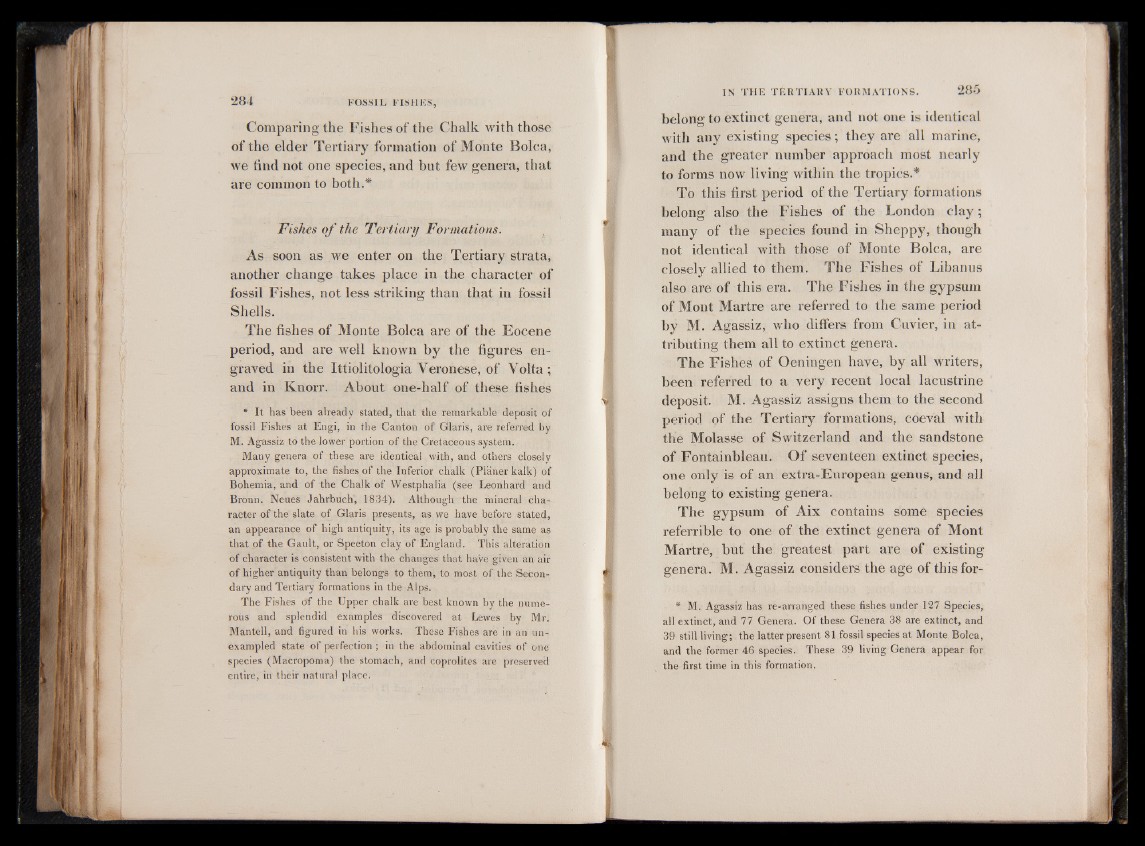
Comparing the Fishes of the Chalk with those
of the elder Tertiary formation of Monte Bolca,
we find not one species, and but few genera, that
are common to both.*
Fishes o f the Tertiary Formations.
As soon as we enter on the Tertiary strata,
another change takes place in the character of
fossil Fishes, not less striking than that in fossil
Shells.
The fishes of Monte Bolca are of the Eocene
period, and are well known by the figures engraved
in the Ittiolitologia Veronese, of Volta ;
and in Knorr. About one-half of these fishes
* It has been already stated, that the remarkable deposit of
fossil Fishes at Engi, in the Canton of Glaris, are referred by
M. Agassiz to the lower portion of the Cretaceous system.
Many genera of these are identical with, and others closely
approximate to, the fishes of the Inferior chalk (Planer kalk) of
Bohemia, and of the Chalk of Westphalia (see Leonhard and
Bronn. Neues Jahrbuch, 1834). Although the mineral character
of the slate of Glaris presents, as we have before stated,
an appearance o f high antiquity, its age is probably the same as
that of the Gault, or Speeton clay of England. This alteration
of character is consistent with the chauges that have given an air
of higher antiquity than belongs to them, to most of the Secondary
and Tertiary formations in the Alps.
The Fishes of the Upper chalk are best known by the numerous
and splendid examples discovered at Lewes by Mr.
Mantell, and figured in his works. These Fishes are in an unexampled
state of perfection ; in the abdominal cavities of one
species (Macropoma) the stomach, and coprolites are preserved
entire, in their natural place.
g
belong to extinct genera, and not one is identical
with any existing species; they are all marine,
and the greater number approach most nearly
to forms now living within the tropics.*
To this first period of the Tertiary formations
belong also the Fishes of the London clay;
many of the species found in Sheppy, though
not identical with those of Monte Bolca, are
closely allied to them. The Fishes of Libanus
also are of this era. The Fishes in the gypsum
of Mont Martre are referred to the same period
by M. Agassiz, who differs from Cuvier, in attributing
them all to extinct genera.
The Fishes of Oeningen have, by all writers,
been referred to a very recent local lacustrine
deposit. M. Agassiz assigns them to the second
period of the Tertiary formations, coeval with
the Molasse of Switzerland and the sandstone
of Fontainbleau. Of seventeen extinct species,
one only is of an extra-European genus, and all
belong to existing genera.
The gypsum of Aix contains some species
referrible to one of the extinct genera of Mont
Martre, but the greatest part are of existing
genera. M. Agassiz considers the age of thisfor-
* M. Agassiz has re-arranged these fishes under 127 Species,
all extinct, and 77 Genera. Of these Genera 38 are extinct, and
39 still living; the latter present 81 fossil species at Monte Bolca,
and the former 46 species. These 39 living Genera appear for
the first time in this formation.